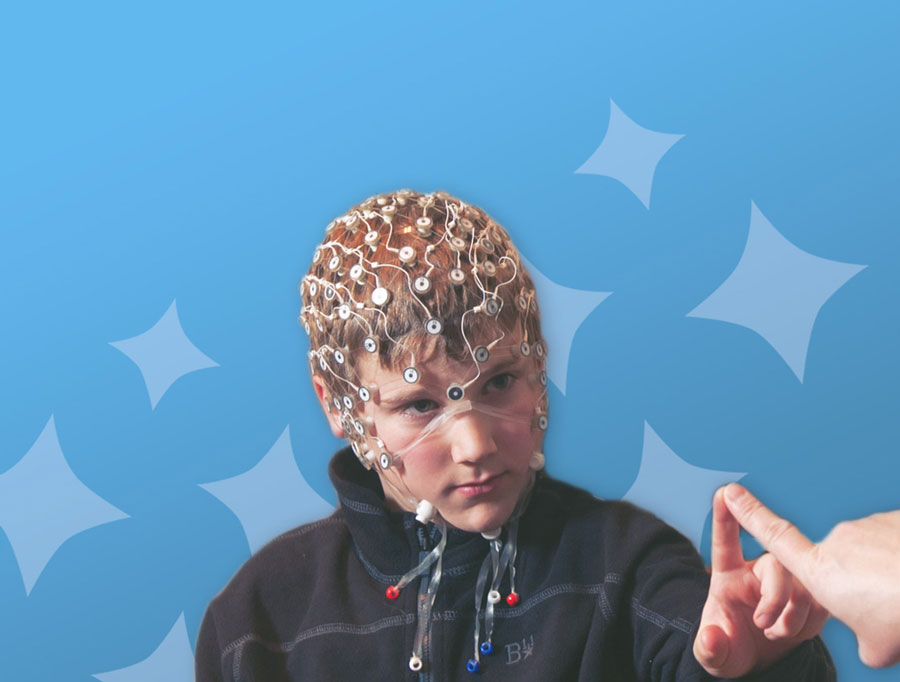HD-EEG stands for High Density Electroencephalogram. ‘Electro’ is easy enough to understand, it refers to electricity. ‘Encephalo’ refers to the brain. As for ‘gram’, this ending means that it is drawn (before computers, the EEG was on paper) or recorded (as it is now, by being saved to a computer’s hard disk). So by ‘EEG’ what we mean is ‘electric-brain-drawing’. However, we are not really drawing a picture of the brain – we are drawing a picture of the activity of the brain. Electroencephalogram and electroencephalography are long words and it’s easy to get caught up in trying to pronounce it, so we simply refer to it as EEG.
Now, the ‘HD’ stands for ‘High Density’. This refers to the fact that unlike a conventional EEG which covers the head with 18-24 electrodes, High Density EEG has 128 ‘electrodes’ for a high-resolution picture of brain activity. That ‘electrode’ part can be unsettling, but it ought not to be. At NeurAbilities (and most everywhere else), no electricity is used in the equipment that gets placed on the head. The sensing part of the equipment, the ‘electrodes’, passively pick up the activity of your brain, much like a camera does with light when someone takes a picture of you. You could call a camera a ‘light –camera’ because it senses light. Similarly, you can think of an electrode as an ‘electric –camera’ because it senses electricity. Our HD-EEG electrodes are simply a wire connected to a tiny plastic disc, with a wet sponge attached to the end.
With HD-EEG, there is NO scraping of the scalp, NO shaving of hair or any of the discomforts experienced with conventional EEG testing. Even our most sensitive patients wear the HD-EEG nets without the need for sedation. The sponge simply rests on the head and is wetted with a mixture of slightly salty water and a little baby shampoo. We need to use water on the little sponges because water helps focus the brain signals so that they can be carried across the sponge to the wire. For best results from your HD-EEG, don’t use hair products before you come in as they could interfere with the signals from your brain. Also, as I mentioned, we use the wet sponge to focus the signal. So, if you come in with your hair wet – it won’t work! So no hair products, and make sure you hair is dry. Then you are good to go!
When people tell me that they’re considering going to a major medical center for a conventional EEG, I ask them, ‘Do they have High Density EEG?’ And when they respond, ‘What’s that?’, I proceed to tell them all the things that make High Density EEG (HD-EEG) so special for our patients…
Ease of use: The electrodes in the HD-EEG system are easy to apply and do not involve any painful or potentially adverse procedures. There is no scrubbing of the scalp, no pastes used for electrode attachment to the scalp, nor is there a need to wash your hair after the exam is complete—all typical of traditional EEG. Our advanced HD-EEG system uses elastic nets to hold the electrodes in place, not paste, and it uses sponges, not metal disks, for electrical pickup.
Lack of restraint: Even when dealing with non-compliant patients, adequate data can be obtained without the use of restraint or sedation. The HD-EEG electrodes go on something like putting on a swimming cap: gentle and painless. In just a couple of minutes they are on and ready to go. At NeurAbilities, we have been successful obtaining HD-EEG’s from highly non-compliant children without ever needing to use sedation or restraint. During a conventional EEG exam, it can take 20 minutes or more to mark up your child’s head, scrub clean the sites and glue the electrodes to the scalp. Even compliant children sometimes need sedation just to get the electrodes placed, and it can take a full day for the effects of sedation to wear off.
More electrodes: More electrodes mean more data and a better chance of detecting even highly localized brainwave “spikes”. Conventional EEG uses 18-24 electrodes. HD-EEG uses 128. This gives us six times as much data, data that we use to more finely examine brain activity and better determine the source of any abnormalities.
Coverage: The HD-EEG net goes around the head and has some coverage of areas below the brain, areas that are not covered in conventional EEG systems. It is not only the number of electrodes that is important—it is where they are placed. Because of the way the cells of the brain are lined up, their activity results in an electric field. The field has a positive and a negative end. This is referred to as a dipole. Because the surface of the brain is wrinkled, this dipole can be pointing in almost any direction, depending on exactly where in the brain it is located. As you might imagine, it is quite a difficult problem to figure out where the activity is occurring in the brain. Having electrodes down the sides of the head means we get a much better picture of both ends of the dipole. If you look at the placement of electrodes on a conventional EEG, you will see that they basically cover only the top of the head. Only seeing half the signal, they simply cannot give as good an answer as to where in the brain abnormal activity is occurring.



